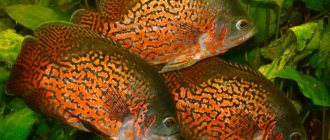Post Views: 452
5
(1)
Aquarium fish simply amaze with their diversity. Representatives of different species can differ from each other in a wide variety of parameters: color, shape, size. There are both miniature creatures, less than 3 cm long, and giants, which, when created under acceptable conditions, grow up to 50 cm. The choice of certain options will directly depend on the preferences of the future owner. In this article I will describe the Top 10 large aquarium fish.
The largest aquarium fish - TOP 10 giants
Despite the fact that some fish are impressive in size, they are very popular because they are often distinguished by complex forms of behavior and beautiful coloring.
Note ! We invite you to familiarize yourself with ten large aquarium fish that do not need miniature aquariums .
Akara turquoise
A fairly large fish native to South America. The maximum body length of the acara reaches 30 cm. The body is silver-gray, the fins are edged with yellow, and there are also green-blue dots on the body.
Akara turquoise
To keep this fish at home, you need an aquarium of at least 300 liters. Turquoise acara is very aggressive, and therefore it is also called “green terror”. Only fish of similar proportions can become neighbors, but this is not a guarantee that cohabitation will be successful. Acara is also distinguished by a pronounced parental instinct; it cares for eggs and fry until they begin to feed on their own.
Kaluga
Kaluga fish is a close relative of the beluga (a freshwater fish of the beluga genus, sturgeon family), and spends its entire life in fresh water. It can be found in the Amur River basin, in a temperate climate zone. On average, the fish reaches a length of 2.5-3 m and a weight of 150 kg. The largest documented individual weighed 382 kg and was 5.5 meters long.
It is believed that the fish can grow up to 8 m and weigh up to 1.5 tons. Kaluga is a predator, feeding mainly on bottom fish. Large kaluga eat chum salmon, pink salmon and even prey on smaller individuals of their own species. Due to uncontrolled fishing, it was on the verge of extinction, so in the mid-20th century it was taken under state protection. Now Kaluga is successfully restoring its population.
Arowana
Arowana is a very unusual fish. It has an elongated body, the length of which in an aquarium can reach 60-100 cm. Perhaps the arowana is the largest aquarium fish . Another feature is its very capacious and unusual mouth, which allows it to swallow even large prey.
Golden Arowana
The volume of an aquarium for an adult arowana should be almost 1000 liters. She floats near the surface, gracefully and sedately. As for the neighbors, these can only be large fish (small ones will definitely become prey for a predator).
Video – Arowana, aquarium fish
Common sunfish
Currently, the common sunfish is the largest of all bony fish. This huge creature, whose body reaches an average of 3 m and weighs up to one and a half tons, lives in tropical waters, the North Atlantic, and is found in the Sea of Japan and near the Great Kuril Ridge.
The disc-shaped moonfish cannot fight fast currents and swims very slowly as it lacks a tail. Most marine predators cannot bite through its very thick and rough skin, so it has practically no enemies. But sometimes he still becomes a victim of sharks, which off the coast of California attack a slow swimmer and bite off his fins, causing the giant to sink to the bottom and die.
Moon fish is very prolific. Females can lay up to 300 million eggs at a time. But only a small part of the offspring survives to adulthood. The basis of nutrition is plankton and all kinds of larvae, fry, and jellyfish.
Astronotus
Another large aquarium fish native to South America is Astronotus. The body size in an aquarium of suitable volume can reach 25-30 cm, although in the wild there are individuals up to 45 cm. Therefore, it is not surprising that Astronotus is a trophy among fans of sport fishing.
Astronotus ocellata
On a note ! The body of the fish is streamlined, beautiful, with a pointed head. Which immediately reveals a predator, ready to pounce on the prey with lightning speed. The color is beautiful, red and black. Astronotus is kept in pairs, but each individual must have at least 100 liters of water. Often loyal to proportionate neighbors.
Lepidosiren, American scaleweed (Lepidosiren paradoxa)
Lepidosiren is a large, growing over a meter, but at the same time peaceful and calm fish from the family of American two-legged fish. In nature, it lives in the waters of South America.
Lepidosiren has a long, powerful, serpentine body with a rounded head on which are located small eyes and a mouth. The color is gray with spots.
Lepidosiren prefers low, diffuse lighting in the aquarium. It is possible to keep it with proportionate and non-aggressive neighbors in a volume of 700 liters.
Pangasius
If you have a large aquarium of 400 liters or more and you want to place a freshwater fish that resembles a shark in it, then pangasius will be the ideal choice! From a distance, it is easy to confuse an adult with a well-known marine predator. In an aquarium, pangasius grows up to 50 cm, although in nature there are also specimens twice as large.
Pangasius
Pangasius loves space and is very active. But he is also extremely timid - any sudden sound or movement causes him to have a panic attack. Suitable neighbors are fish that will not fit into the predator's mouth .
Mastacembelus erythrotaenia
Mastacembelus is a serpentine fish from the proboscis family that prefers bottom layers of water. In nature, it lives in the waters of Malaysia and Thailand. Mastacembelus grows up to one meter. He has a powerful, elastic, highly elongated body with a narrowed head. The coloring is very attractive: dark with horizontal red stripes.
Mastacembelus is unpretentious, but it is voracious; it can only be kept with comparable, active fish. An aquarium for an adult is suitable from 700-1000 liters. The aquarium must be tightly closed with a lid to prevent Mastacembelus from escaping from it.
Piranha
No other fish scares a person as much as the piranha. Numerous speculations and rumors about her bloodthirstiness are firmly entrenched in our minds. But people who do not share this point of view successfully keep these interesting fish in home aquariums.
Piranha
The body size of an adult piranha can reach 35 cm. It is a schooling fish, and therefore needs to be kept in groups in an aquarium with a volume of at least 300 liters. It is better not to add other fish to piranhas, since conflict cannot be avoided.
Video - Keeping piranhas in an aquarium
Pterygoplicht brocade
Pterygoplicht brocade, or giant sticky catfish, is one of the largest representatives of its family. The body size from the tip of the tail to the head can reach 50 cm.
Pterygoplicht brocade
Note ! Despite its size, it is a herbivorous catfish, which means it will not hunt its neighbors in the aquarium. The minimum volume of the tank for keeping pterygoplichts is 250 l.
Parrot fish
The parrotfish, which is the result of crossing some species with cichlases (it is not known exactly which ones), is very popular among aquarists. This easy-to-care fish is distinguished by its bright color (often red), slight clumsiness when swimming and a constant “smile” on its face.
Parrot fish
If the volume is suitable, parrot fish can grow up to 25-30 cm. It requires an aquarium of 250 liters or more. Typically, these fish are sterile, and therefore it is impossible to get offspring from them, even despite regular spawning .
Hexamitosis, or hole disease
Fin rot in aquarium fish
Why do fish die in an aquarium?
White small worms on the glass of an aquarium
Flower Horn
Like the parrot fish described above, this is the creation of Asian breeders. Flower Horn is distinguished by one feature - it is a very developed fatty growth on the head . Moreover, the larger the growth, the more valuable the fish! The body length of this giant reaches 40 cm.
Flower Horn
The minimum volume of water per individual is 150 l; in the case of group housing - from 800 liters. Which is not surprising, because the fish has increased territoriality. But Flower Horn, unlike parrot fish, reproduces without problems at home.
Frontosa
It is no coincidence that this beautiful fish was called the “Queen of Tanganyika”. It would be hard to find a more beautiful and majestic cichlid with a wonderful striped color! The length of adults can reach 30 cm.
Frontosa
Important ! Frontoses are kept by a harem consisting of a male and a group of females. The volume of the aquarium should be at least 300 liters. Gets along well with other cichlids.
The largest river fish in Russia...was
Beluga is the largest river fish in Russia. Lives in both sea and fresh water. Because of its enormous size it is called the “king fish”. The beluga grows continuously throughout its life. The largest individuals reached a length of 8 meters and weighed about two tons. In 1827, the capture of a beluga weighing 1.5 tons was documented. Almost a hundred years later, in 1922, a fish weighing 1224 kg was caught at the mouth of the Volga. The national museum of the Republic of Tatarstan contains a beluga skin 4 m long; the weight of the fish when caught was more than a ton.
Source https://yaustal.com/s_miru_po_nitke/43356-samye-bolshie-rechnye-ryby-v-rossii.html
Chukuchan
Chukuchan (another name is the Chinese sailfish) is one of the largest and most unusual aquarium fish. The body has a triangular shape and can reach a length of 30 cm. The dorsal fin is well developed. But, despite its decent size, the Chukuchan is a completely peaceful fish that feeds on algae (as evidenced by its suction cup mouth).
Chukuchan
We recommend keeping Chinese sailfish in small groups. There should be no problems with the placement of young individuals - a 300 liter aquarium is enough for them. But for adult fish you will need a larger tank - from 1000 liters.
Greenland shark
The Greenland shark spends its entire life in the northern part of the World Ocean. In winter they swim to the coast, and in summer they go deeper. This fish is one of the largest in the world. The average size of representatives of the species is up to 5 m, and their weight is up to 400 kg. But there are also real giants. The length of the largest ones is more than 7 m. They are considered superpredators. They feed on seals, stingrays, and fish. They are cannibals and do not disdain carrion.
Scientists studying Greenland sharks say they have the longest lifespan of any vertebrate. They live for about 500 years. In some countries they are still considered a commercial species. Only their liver is valuable; the meat is considered poisonous due to the high content of urea and trimethylamine oxide, which allows sharks to dive to depths of up to 2 km.
FAQ. Questions and answers on keeping aquarium fish
What to do with the fish if we go on vacation?
Large fish (more than 10 cm) can easily live without food for 5-10 days, and there will be no harm to health. It is also worth mentioning special automatic feeders that can feed your fish for 7-14 days. In any case, you can’t throw a lot of food into the aquarium at one time - they won’t eat it anyway, but the water will spoil, which will lead to the death of the pets.
What to do if the water in the aquarium turns green?
This could happen due to direct sunlight. Or, alternatively, it is an outbreak introduced with new plants.
Why do fish swim on top and often open their mouths?
There is only one reason - the fish do not have enough air. In this case, you need to check its supply to the aquarium.
Is a filter necessary in an aquarium?
Certainly. To keep aquarium fish, you must have a filter , compressor and heater.
Scat
0
Third place on our list of the ten largest freshwater fish in the world is the stingray. Stingray is a beautiful predatory fish that can be found in tropical seas, in the waters of the Arctic and Antarctica, as well as in fresh water bodies. Fish of this species are most common in Asia. Stingrays inhabit both shallow and deep water. The most gigantic individuals reach up to 7-8 m in length. In this case, the stingray can gain weight up to 600 kg. Large fish feed preferably on echinoderms, crayfish, mollusks and small fish.











